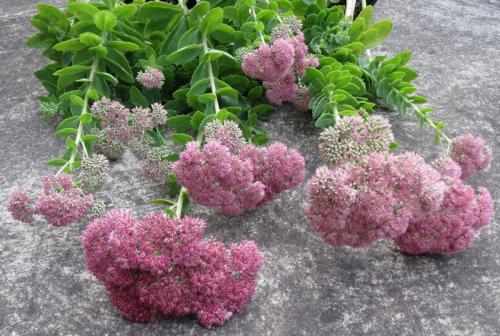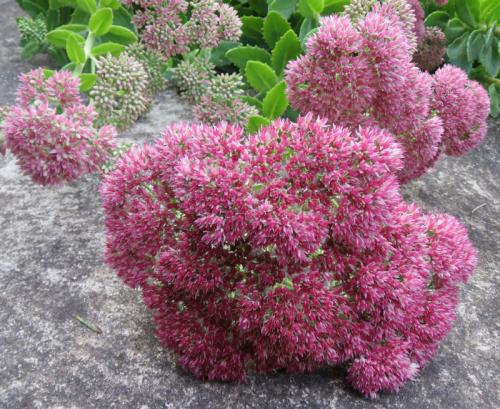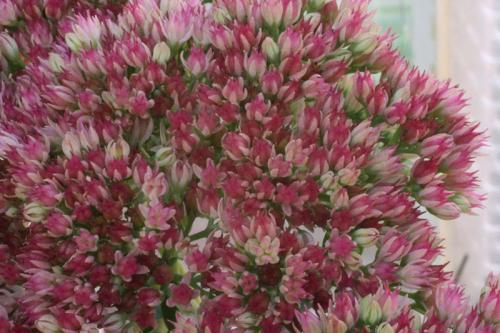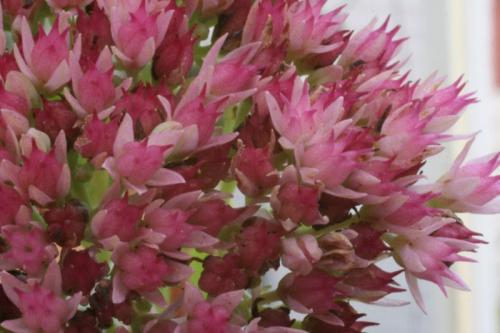Herbstfreude
Synonyms : ‘Autumn Joy’, ‘Indian Chief’
Raised by Georg Arends, 1955.
Synonyme : ‘Autumn Joy’, ‘Indian Chief’
Züchtung von Georg Arends, 1955.
'Autumn Joy' / ['Herbstfreude'] is the most common tall clone in genus Hylotelephium in parks and gardens in Europe and the United States. Growing to 60 cm (24 in) high or more, it throughly deserves its popularity. Renowned for its huge convex cymes of purple flowers late in the year, which attract butterflies in profusion at a time of the year when little else is flowering, it soon forms a glaucous, almost spherical, herbaceous mound. It is a hybrid between Hylotelephium telephium [ssp. maximum] and H. spectabile as the pollen parent.
Habitat : This hybrid is of garden origin, appearing in Europe in 1955. Perhaps it is more correct to refer to it as 'Herbstfreude', but in English speaking countries 'Autumn Joy' is well known and widely used.
Main points of distinction : Flowers have no male parts (i.e., no stamens or anthers). Petals are light pink, but the flower color is dominated by fleshy, dark pink-purple carpels compacted on flat-topped umbels. Vegetatively this cultivar could be (and often is) confused with H. spectabile, but the latter has less-dentate, light green leaves and is usually much shorter in stature. 'Autumn Joy' leaves are blue-green, the largest of any stonecrop, and extremely dentate (Leaf shapes, fig. 1n). Upper leaves are much smaller than lower leaves and have a different shape. Flowers are distinct and a stark contrast to those of H. spectabile with its very long stamens.
Variation : As plants are always cloned from vegetative propagations, every plant in cultivation should be identical, but growing conditions do make some difference: in a well-manured border, plants can be a meter (3 ft) high and a meter (3 ft) across, but in poorer soil, the show is less impressive.
Horticulture : Perhaps this is one of the easiest stonecrops to grow - hence its wide distribution in parks and gardens. Generally, roots are divided in spring and allowed to dry out thoroughly under a bench (perhaps in a greenhouse) before replanting. It is just as easy for cuttings to be rooted up in spring from new stems (on which it only takes a few weeks for the carrotlike roots to develop), although such cuttings may not flower in their first year.
Drying stems produce heads of rust-colored fruit in early winter, and these can be taken and dried artificially for use in flower arrangements. This has become a very important plant for flower arranging on both sides of the Atlantic. Heads can be dyed or painted, and the dried stems and inflorescences are long-lasting and tend not to break up because they are sterile.
[See also 'Autumn Charm', 'Autumn Delight', 'Elsie's Gold' and 'Mini Joy']
Ray Stephenson (Sedum, Cultivated Stonecrops, 1994, p 276)
Note :
The recently published name “Hylotelephium x mottramianum” is complete nonsense. A deliberately bred hybrid (of two plants in cultivation) cannot possibly be a nothospecies.



